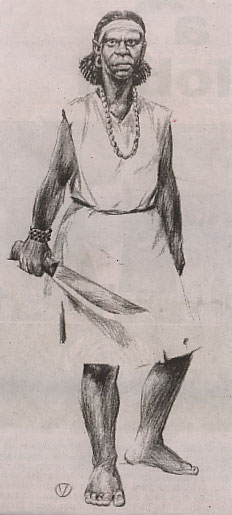Deadliest Black/African Warriors!!!! - Foreign Affairs (2) - Nairaland
Nairaland Forum / Nairaland / General / Politics / Foreign Affairs / Deadliest Black/African Warriors!!!! (137319 Views)
Dahomey Women Warriors - Nigerias Deadliest Fighting Force! / Black African Nobility Of Ancient Europe / Are You Proud To Be Black, African, Nigerian, Cameroonian, Igbo? Well, Not Me! (2) (3) (4)
(1) (2) (3) (4) (5) (6) (7) (8) (9) (10) (Reply) (Go Down)
| Re: Deadliest Black/African Warriors!!!! by Nobody: 1:26am On Apr 20, 2013 |
Antonio Maceo Grajales(Afro-Cuban) Lt. General José Antonio de la Caridad Maceo y Grajales (June 14, 1845 – December 7, 1896) was second-in-command of the Cuban Army of Independence. Fellow Cubans gave Maceo the sobriquet of the "Bronze Titan" (Spanish: El Titan de Bronce), which was a reference to his skin color, stature and status. Spaniards referred to Maceo as the "Greater Lion" (El Leon mayor). Maceo was one of the most noteworthy guerrilla leaders in 19th century Latin America, comparable to José Antonio Páez of Venezuela in military acumen. Source: http://www.redirectify.com/people/antonio-maceo-grajales.html Some more info... http://en.wikipedia.org/wiki/Antonio_Maceo_Grajales |
| Re: Deadliest Black/African Warriors!!!! by Nobody: 1:27am On Apr 20, 2013 |
Musevini |
| Re: Deadliest Black/African Warriors!!!! by somalia9: 1:31am On Apr 20, 2013 |
Asli Hassan Abade (Somali: Asli Xasan Cabaade; Arabic: عسلي حسن آباد) was the first and so far only female pilot in the Somali Air Force (SAF).[1] A prominent member of the SAF, she paved the way for gender equality within the military ranks.[2]
|
| Re: Deadliest Black/African Warriors!!!! by somalia9: 1:33am On Apr 20, 2013 |
Salaad Gabeyre Kediye (Somali: Salaad Gabeyre Kediye, Arabic: صالاد غابييري خيدييي) (d. 1972), also known as Salah Gaveire Kedie,[1] was a Somali senior military official and a revolutionary.
|
| Re: Deadliest Black/African Warriors!!!! by somalia9: 1:35am On Apr 20, 2013 |
Abdullahi Yusuf Ahmed was a Somali politician. He was one of the founders of the Somali Salvation Democratic Front, as well as the Puntland State of Somalia, where he served as the autonomous region's first President. Wikipedia
|
| Re: Deadliest Black/African Warriors!!!! by Nobody: 1:36am On Apr 20, 2013 |
Riley L. Pitts(African American) [img]http://1.bp..com/-Q_Jkv0WQ5qg/TVNKDLuzFpI/AAAAAAAAEjM/9x-W2NI2HiA/s400/pitts1.jpg[/img] Medal of Honor citation Rank and organization: Captain, U.S. Army Place and date: October 31, 1967, Ap Dong, South Vietnam Distinguishing himself by exceptional heroism while serving as company commander during an airmobile assault. Immediately after his company landed in the area, several Viet Cong opened fire with automatic weapons. Despite the enemy fire, Capt. Pitts forcefully led an assault which overran the enemy positions. Shortly thereafter, Capt. Pitts was ordered to move his unit to the north to reinforce another company heavily engaged against a strong enemy force. As Capt. Pitts' company moved forward to engage the enemy, intense fire was received from 3 directions, including fire from 4 enemy bunkers, 2 of which were within 15 meters of Capt. Pitts' position. The severity of the incoming fire prevented Capt. Pitts from maneuvering his company. His rifle fire proving ineffective against the enemy due to the dense jungle foliage, he picked up an M-79 grenade launcher and began pinpointing the targets. Seizing a Chinese Communist grenade which had been taken from a captured Viet Cong's web gear, Capt. Pitts lobbed the grenade at a bunker to his front, but it hit the dense jungle foliage and rebounded. Without hesitation, Capt. Pitts threw himself on top of the grenade which, fortunately, failed to explode. Capt. Pitts then directed the repositioning of the company to permit friendly artillery to be fired. Upon completion of the artillery fire mission, Capt. Pitts again led his men toward the enemy positions, personally killing at least 1 more Viet Cong. The jungle growth still prevented effective fire to be placed on the enemy bunkers. Capt. Pitts, displaying complete disregard for his life and personal safety, quickly moved to a position which permitted him to place effective fire on the enemy. He maintained a continuous fire, pinpointing the enemy's fortified positions, while at the same time directing and urging his men forward, until he was mortally wounded. Capt. Pitts' conspicuous gallantry, extraordinary heroism, and intrepidity at the cost of his life, above and beyond the call of duty, are in the highest traditions of the U.S. Army and reflect great credit upon himself, his unit, and the Armed Forces of his country. Source: http://en.wikipedia.org/wiki/Riley_L._Pitts |
| Re: Deadliest Black/African Warriors!!!! by Nobody: 1:40am On Apr 20, 2013 |
I'm confused,  How those last one are deadliest?  |
| Re: Deadliest Black/African Warriors!!!! by Nobody: 1:41am On Apr 20, 2013 |
CAMEROONPRIDE: I'm confused, Need some AA warriors...Not that many.  |
| Re: Deadliest Black/African Warriors!!!! by Nobody: 1:42am On Apr 20, 2013 |
Kyriakos of Makuria(Nubian) Kyriakos or Cyriacus (ca. 750) was a ruler of the Nubian kingdom of Makuria. While some authorities place his reign between Merkurios and Zacharias I, according to Severus of El Ashmunein, Kyriakos succeeded Markos. Around 748, Kyriakos marched north into Egypt at the head of an army said to number 100,000 men to free the Patriarch of Alexandria Michael, whom Abd al-Malik had thrown into prison. However, once the Makurian army reached Egypt, the Patriarch was released from prison, along with Kyriakos' envoy, who was then dispatched to Kyriakos to ask him to return to Makuria. Source: http://en.wikipedia.org/wiki/Kyriakos_of_Makuria |
| Re: Deadliest Black/African Warriors!!!! by Nobody: 1:44am On Apr 20, 2013 |
Somalian something stop spamming the thread .. How are they warriors talk less about deadliest 3 Likes |
| Re: Deadliest Black/African Warriors!!!! by somalia9: 1:45am On Apr 20, 2013 |
well all those deadly black warriors didnt stop your people from getting enslaved  |
| Re: Deadliest Black/African Warriors!!!! by Nobody: 1:47am On Apr 20, 2013 |
Pharoah Piye of Nubia(Kushite) As ruler of Nubia and Upper Egypt, Piye took advantage of the squabbling of Egypt's rulers by expanding Nubia's power beyond Thebes into Lower Egypt. In reaction to this, Tefnakht of Sais formed a coalition between the local kings of the Delta Region and enticed Piye's nominal ally—king Nimlot of Hermopolis—to defect to his side. Tefnakht then sent his coalition army south and besieged Herakleopolis where its king Peftjaubast and the local Nubian commanders appealed to Piye for help. Piye reacted quickly to this crisis in his Year 20 by assembling an army to invade Middle and Lower Egypt and visited Thebes in time for the great Opet Festival which proves he effectively controlled Upper Egypt by this time. His military feats are chronicled in the Victory stela at Gebel Barkal. Piye viewed his campaign as a Holy War, commanding his soldiers to cleanse themselves ritually before beginning battle. He himself offered sacrifices to the great god Amun. Piye then marched north and achieved complete victory at Herakleopolis, conquering the cities of Hermopolis and Memphis among others, and received the submission of the kings of the Nile Delta including Iuput II of Leontopolis, Osorkon IV of Tanis and his former ally Nimlot at Hermopolis. Hermopolis fell to the Nubian king after a siege lasting five months. Tefnakht took refuge in an island in the Delta and formally conceded defeat in a letter to the Nubian king but refused to personally pay homage to the Kushite ruler. Satisfied with his triumph, Piye proceeded to sail south to Thebes and returned to his homeland in Nubia never to return to Egypt. Source: http://en.wikipedia.org/wiki/Piye |
| Re: Deadliest Black/African Warriors!!!! by Nobody: 1:52am On Apr 20, 2013 |
Robert Mugabe(Zimbabwean)  The Rhodesian Bush War is another great example of Blacks defeating Whites.... http://en.wikipedia.org/wiki/Rhodesian_Bush_War This is when Robert Mugabe was a complete bad*ss. His economic policies suck but he should be commended for his military victory against Whites, along with that of Joshua Nkomo. |
| Re: Deadliest Black/African Warriors!!!! by Nobody: 2:05am On Apr 20, 2013 |
King Ramses II(Kemetian) [img]http://egypte.nikopol.free.fr/Louvre/Resources/ramses2ankh.jpeg[/img] ^^^Probably the most deadliest African man who ever lived! Due to the volatile political climate of that time, Ramses II strived to secure Egypt’s border from various revolts just as his father had done. These attacks and revolts came from the Nubians, the Libyans, and the Hittites. As a result of these revolts he had built up a huge Egyptian army force of approximately 100,000 men. Within the first two years of his reign, Ramses II had to protect the Egyptian Mediterranean coast by defeating the Sherden sea pirates who created havoc by attacking any cargo-laden vessels that were in route to Egypt. He strategically posted surprise attacks on these pirates and was eventually able to capture them all in a single battle along with the Lukka and the Shekelesh peoples. This victory then gave Ramses II advantage and control over the Mediterranean coast. Two years later, Ramses II fought against a Palestinian Prince that was mortally wounded by an Egyptian archer. The Palestinian Prince’s army was forced to retreat and the Prince was taken prisoner. Thereafter, Ramses II was able to safely plunder the Asiatic lands. During this fourth year, he was also able to capture the Hittite state of Amurru in Syria. This provided him with further power and wealth. Ramses II was a great military commander just like his father had been. He didn’t let up his fight against the Hittites. The Hittites were determined to retain control of North Syria; however, in July 1274 BC, Ramses II recaptured the Syrian City of Kadesh and this became one of his greatest battles as pharaoh. Egypt had lost this city during the reign of the heretic king Akhenaten and Ramses II had taken it back. According to ancient writing, this heroic battle encompassed over 5,000 chariots during battle. In that same year he also developed a new capital called Pi-Ramses. This new capital became a forefront for manufacturing various battle weapons such as chariots and shields. It was these weapons that most likely helped him achieve victory against the Hittite Empire in Kadesh; however, during this Hittite attack, Ramses II was ambushed and suffered many losses. The battle was mostly a stalemate, but it did not preclude Ramses II from proclaiming victory and showing this through inscriptions on the temples of Ramesseum, Abydos, Karnak, Luxor and Abu Simbel. There are historians that continue to proclaim that this battle was only a shallow victory for Ramses II because Egyptian forces were not able to really occupy the city or territory around Kadesh. Seven years into his reign, Ramses II decided to again go into Syria and this time was more successful against the Hittites. Splitting his army into two forces and with the help of his son he was able to expand his territory once again. He continued to move on to northern Amurru into Tunip and captured that city as well; however, that victory was short lived. Within the year the Hittites took the territory back. Ramses II once again battled to recover this territory and this time six of his sons participated in this endeavor. After 20 years of conflict with the Hittites, Ramses II decided to put an end to the turmoil. An agreement was then made between Ramses II and the Hittite King, Hattusili III, at Kadesh. This peace treaty was recorded in two language versions; Egyptian Hieroglyphs and Akkadian which used the cuneiform script; cuneiform script is one of the earliest forms of written expression. Each agreement included verbiage that accused the other party of “begging for peace” and was most likely done to safe face by both sides. Eventually this agreement was carved into the Temple of Karnak. Thirty four years into Ramses II’s reign and 13 years after the treaty was in place with the Hittites, Ramses II married the daughter of the Hittite prince. Her name was Ueret-ma-a-nefe. This marriage helped to further solidify the treaty and to continue the peace between Ramses II and the Hittite Empire. In addition to the battles against the Hittites, there are also depictions of campaigns and skirmishes with the Nubians and the Libyans. One temple makes reference to Ramses II fighting a battle against the Nubians with no assistance from his troops. In other instances there are references of Ramses II conquering and crushing the Libyans but no specific details are provided. So what made Ramses II a great leader? No one knows for sure, but what is known is that at the Temple of Seti I at Abydos, there is a great account detailing Ramses II’s childhood. It indicates that he was made a General at the age of 10 years old and was making administrative decisions at this young age. This leads us to conclude that his father had begun preparing Ramses II (at a very young age) to take the place of Pharaoh upon his demise. The Hittites were an Indo-European people that had destroyed the Babylonian Empire and thus were feared throughout. Although Ramses II’s father had realized many victories in retaining the disputed territories for Egypt during his reign, he was not able to totally destroy the Hittites before he died; thus, this task was left to Ramses II to handle as the new pharaoh of Egypt. Today we know of Ramses II father’s military victories and successes because these were captured and recorded on the front of the temple of Amun located in Karnak. Ramses II came to rule over the largest empire known in the ancient world. His rule overlooked territory from the African Desert to the Mediterranean Sea. Overseeing territory of this size was both an advantage and a curse. It was an advantage because it gave him power; however, it was also a curse in that it brought upon many enemies causing much turmoil throughout his kingdom. Source: http://www.kingtutone.com/pharaohs/ramses2/battles/ |
| Re: Deadliest Black/African Warriors!!!! by Nobody: 2:33am On Apr 20, 2013 |
Sundiata Keita(Malian) [img]http://1.bp..com/_sz7leAQs4ww/SXVIxeM0g3I/AAAAAAAAAQI/7OXZWZmeHn0/s320/kpq_mansamusa.jpg[/img] In about the year 1240, according to tradition, the Mandingo ruler Sundiata Keita fought a crucial battle against the Sosso (Fulah) King Sumanguru, and won. This is generally accounted as the beginning of the empire of Mali. An anonymous manuscript in Arabic, recovered and translated by the late Maurice Delafosse, tells the story of this battle as popular memory recorded it long afterwards. ------------------- As Sundiata advanced with his army to meet Sumanguru, he learned that Sumanguru was also coming against him with an army prepared for battle. They met in a place called Kirina [not far from the modern Koulikoro]. When Sundiata turned his eyes on the army of Sumanguru he believed they were a cloud and said: "What is this cloud on the eastern side?" They told him it was the army of Sumanguru. As for Sumanguru, when he saw the army of Sundiata, he exclaimed: "What is that mountain of stone?" For he thought it was a mountain. And they told him: "It is the army of Sundiata, which lies to the west of us." Then the two columns came together and fought a murderous battle; in the thick of the fight, Sundiata uttered a great shout in the face of the warriors of Sumanguru, and at once these ran to get behind Sumanguru; the latter in his return uttered a great shout in the face of the warriors of Sundiata, all of whom fled to get behind Sundiata. Usually, when Sumanguru shouted, eight heads would rise above his own head. When they had done this, Sundiata said to Sangaran Danguinia Konnte: "Have you forgotten the taboo?" [A reference to an earlier prophecy of Sumanguru's imminent downfall, and the manner of its bringing about.] As soon as Sangaran Danguinia heard Sundiata's question he came to the front of the army, halted, grasped the arrow (spear?) armed with the spur of a white cock, and threw it at Sumanguru. As soon as it had struck Sumanguru, Sangaran said: "This is the arrow of him who knows the ancient secrets . . ." While he was saying this, Sumanguru vanished and was seen no more. Now he had had a gold bracelet on his wrist, and this fell on that spot [i.e., at Kirina]; a baobab tree grew out of it and carries the mark to this day. [Fifty years ago, it is said, the people of Kirina would still show their visitors a baobab tree which they held to be the same one as grew there on the day of Sundiata's famous victory.] . . . As for Sundiata, he defeated the army of Sumanguru, ravaged the land of the Susu [Soso] and subjugated its people. Afterwards Sundiata became the ruler of an immense empire [Mali] . . . Source: http://wysinger.homestead.com/Sundiata-Keita.html Mali Empire: 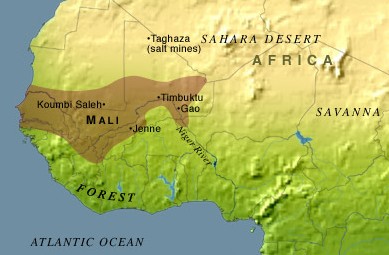 |
| Re: Deadliest Black/African Warriors!!!! by Nobody: 2:39am On Apr 20, 2013 |
Ethiopian forces inflicted the most casualties of ANY major battle of the 19th century. Furthermore they used modern arms effectively, with one of their artillery batteries, playing a key role in the battle, outgunning artillery fired by the Italian forces at a crucial phase. QUOTE:  "Baratieri's army suffered 50 percent casualties, far higher than those suffered by participants in any other major battle of the nineteenth century. Eylau, the greatest blood-letting of the Napoleonic era, cost the French army casualties of 33.8 per cent and its losses at Waterloo were just under 30 per cent. "Macello, carneficina, strage" (butchery, slaughterhouse, slaughter) are the words which recur in the memories of the Italian combatants at Adowa." --Bruce Vandervort, Wars of Imperial Conquest in Africa: 1830-1914, Indiana University Press: 1998, pp. 39 |
| Re: Deadliest Black/African Warriors!!!! by GoldenLady1: 2:47am On Apr 20, 2013 |
Nice thread (following). |
| Re: Deadliest Black/African Warriors!!!! by Nobody: 2:48am On Apr 20, 2013 |
Golden Lady: Nice thread (following). Thank you.  |
| Re: Deadliest Black/African Warriors!!!! by somalia9: 2:51am On Apr 20, 2013 |
this thread is afrocentrism combined with nostalgia combined with a bad case of alzeimers if your posting nigerian heroes thats one thing....but going around a posting black "warriors" pictures is kinda dilusional not to mention only taking the shiny side of their history and leaving out the terrible things they did. imagine if a white guy started posting all the white warriors of the world? why is it always negroids who do this type of stuff? you never see ethiopians or somalis posting pictures of random africans who are warriors. its better to stick to ur culture and salvage what little is left in between your tribal wars and the time of the atlantic slave trade. |
| Re: Deadliest Black/African Warriors!!!! by Nobody: 2:52am On Apr 20, 2013 |
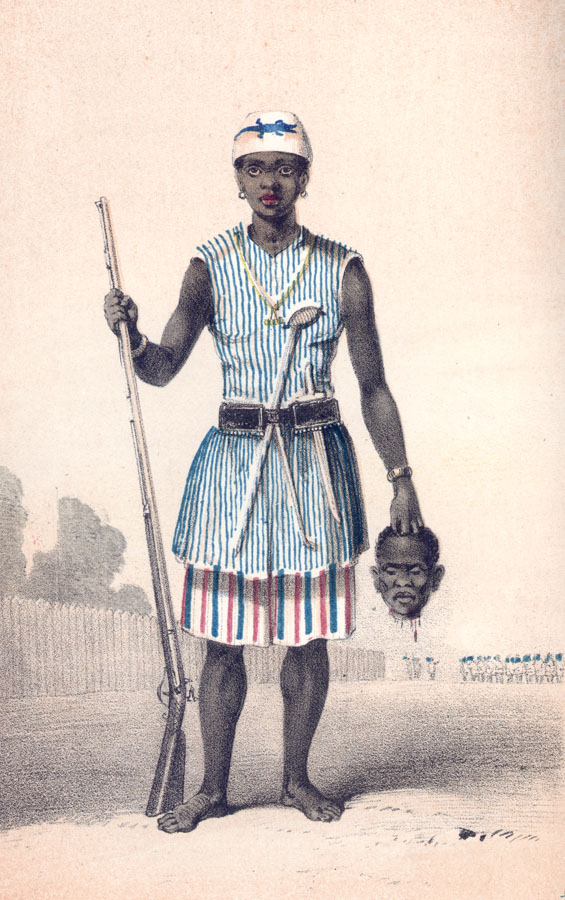 The Mino were recruited from among the ahosi ("king's wives" ) of which there were often hundreds. Some women in Fon society became ahosi voluntarily, while others were involuntarily enrolled if their husbands or fathers complained to the King about their behaviour. Membership among the Mino was supposed to hone any aggressive character traits for the purpose of war. During their membership they were not allowed to have children or be part of married life. Many of them were virgins. The regiment had a semi-sacred status, which was intertwined with the Fon belief in Vodun. The Mino trained with intense physical exercise. Discipline was emphasised. In the latter period, they were armed with Winchester rifles, clubs and knives. Units were under female command. Captives who fell into the hands of the Amazons were often decapitated. European encroachment into west Africa gained pace during the latter half of the 19th century, and in 1890 King Behanzin started fighting French forces in the course of the First Franco-Dahomean War. According to Holmes, many of the French soldiers fighting in Dahomey hesitated before shooting or bayoneting the Mino. The resulting delay led to many of the French casualties. However, according to at least two easily-identifiable sources, the French army lost several battles to them—not because of French "hesitation," but due to the female warriors' skill in battle that was "the equal of every contemporary body of male elite soldiers from among the colonial powers" Ultimately, bolstered by the Foreign Legion, and armed with superior weaponry, including machine guns, as well as cavalry and Marine infantry, the French inflicted casualties that were ten times worse on the Dahomey side. After several battles, the French prevailed. The Legionnaires later wrote about the "incredible courage and audacity" of the Amazons. The last surviving Amazon of Dahomey died in 1979. http://en.wikipedia.org/wiki/Dahomey_Amazons 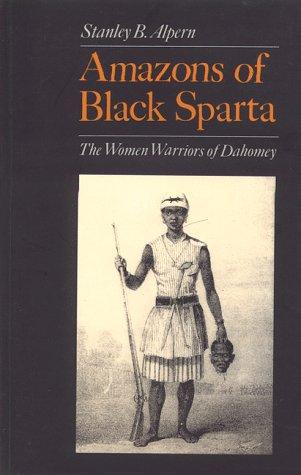 |
| Re: Deadliest Black/African Warriors!!!! by Nobody: 3:25am On Apr 20, 2013 |
Ashanti Warriors  Ashanti-Anglo Wars: Of the many scattered imperial, inter-state, or civil conflicts which comprise the martial history of Africa, most certainly the longest and drawn out conquests & military actions were the wars waged in the Gold Coast, by the British Empire in what is now the Republic of Ghana in West Africa. [img]http://1.bp..com/-S2vGEC3xccg/UPjoNjCkHyI/AAAAAAAADE4/5O-Bj00aHN0/s400/Ashanti+War.jpg[/img] Of the most powerful tribes and cultures, the Asante Empire (alternatively Ashanti or Ashantee) becomes arguably the most powerful military power in all of Africa’s history, perhaps only challenged by the Zulu of South Africa and maybe even the Mahdist warriors of Sudan, Egypt, and Ethiopia in the late 1890's. Starting in the early 1700’s with King Osei Tutu and continuing with his successor Opoku Ware, the Asante Empire with its capital at Kumasi, were unquestionably the strongest military presence in West Africa in the 1700’s and 1800’s. Eventually they would only be rivaled by a modern British Army who campaigned in 1873-1874. One major factor in the Asante’s dominance over their Empire was the amount of muskets that they were able to trade for with their countries great wealth in gold, which was used as a status symbol amongst the royalty and upper classes of the Asante. Trading with Europeans, Arabs, and Asians (Malaysians, Indians, Chinese) who came to West Africa in search of slaves, gold, and plunder beginning in the late 1400’s with the Portuguese and continuing with the Dutch and the later the British, who established a protectorate in 1821 in part due to the Act of Parliament which outlawed the Slave Trade in 1807 (outlawing slavery in 1833). Britain’s long standing war with the Asante came about in the midst of the great imperial age in which most of Europe brutally carved up Africa for colonial-economic interests. The Gold Coast was no exception and the British were careful to appease the Asante Empire with treaties of ‘friendship’ in 1817 and open trade into the 1860’s. To highlight the scale of the Gold Coast musket trade, Britain alone sold over 52,000 guns plus 2 million pounds of gunpowder in just 1829, in the 1830’s the Asante empire place orders for tens of thousands of muskets to the Dutch to further their advantage against their neighboring enemies in the Gold Coast. Together with the slave trade, and the world’s appetite for gold, firearms sales were pivotal to the growing conflict that developed between Queen Victoria’s Empire and the Empire of the Asante Kings. Militarily speaking the Asante dominated their native African foes to the northern tribes and the Fante tribal confederacy to the south because of their firearms. They became the only African empire of the 1800’s to employ large numbers of musket/rifle firing soldiers who could fire in volley or at least bring sustained fire at enemies very close when commanded to by their tribal officers and royal generals. Though renowned for their discipline, and for their fighting prowess & courage like the Zulu of 1879, the Asante of 1873-1874 like the Zulu fives years later were dreadfully inaccurate with their firearms seeing as most were outdated. Even worse they fired antique musket balls ignited by inferior and sometimes volatile cheap gunpowder sold to them by opportunistic European traders. Opposing force, British Army 1823-1874 Throughout the most critical and major uprisings of the Anglo-Asante Wars 1823 to 1874, the British army as a case study of imperial armies is nothing short of fascinating. Just as the Asante warriors are fascinating for their unique cultural and social identities as they relate to warfare, the British army was a product of its own diverse and somewhat close knit military system that held the queen, the regiment, the officers, and then lastly the enlisted man in highest esteem. The British Army of the first Anglo-Asante War was essentially a Napoleonic force under the governor general of Sierra Leone Sir Charles McCarthy. Later in the Third Anglo-Asante War and into the Zulu War, the British army, at least its land forces were markedly different institutions, beginning to modernize and move away from the old way of military thinking that dominated the English military branches from 1799-c.1855. Still however "old ways die hard" and the change was moderate, only completely changing into middle of the Great War in 1915-1916. One very ironic commonality which can be found in the history of the British Army throughout the imperial age is that very few of the fighting men were indeed British by birth in many of the regiments on campaign. The majority were Welsh, Scots, Irish, Canadian, Australian, New Zealanders, Indian, Sikh, West Indian, or any number of differing cultural and ethnic backgrounds recruited as levies, private soldiers, and commissioned & career officers for service in Her Majesties armed forces, during the many campaigns of Queen Victoria’s reign 1837-1901. Sir Charles McCarthy (b.1764-1824), an Irishman, killed in the first great Asante victory over the British near the Pra River in 1824, represents the two separate, unequal, and markedly different groups of the British army during the imperial age. He was both a gentleman officer but somewhat of an outsider since he was Irish born. Regardless he was a well respected officer who had served a number of positions in Africa before being elected Governor of Sierra Leon. Having supreme confidence that his numerically inferior forces could defeat the Asante in the field, Sir Charles divided his forces (the great equalizer in imperialist/colonialist conflicts from 1800-1900) then blundered into an ambush trying to find his other columns. In a bloody assault which showcased the signature battle tactic of the Asante Empire’s forces, over 180 British army soldiers lay dead, more than 80 were wounded many dieing of wounds later. With few of his men escaping the carnage, Sir Charles shot himself rather than be taken alive, the Asante apparently beheading him and then cutting out his heart and consuming it. (H.J. Ricketts, Narrative of the Ashantee (Asante) War, London:1831). As was the tradition in many African warrior cultures of the era, if a slain enemy had fought bravely an organ was consumed from the courageous warrior to imbibe the living with even more power, a frightful image then as it is now, an important part of the battlefield psyche of this era and if exaggerated in use and practice. Wolseley's campaign marked the change from the Napoleonic style army of Sir Charles era, to a more professional and prepared force led by younger, more ambitious officers who had studied military tactics and strategy scientifically as opposed to classically. These read histories of more modern conflicts like the American Civil War 1861-1865, and former accounts of explorers and scouts to familiarize themselves with the Gold Coast specifically in 1872-1873. However the men and officers of the Imperial Age still looked down on the warriors of Africa during this era, known by imperialist officers and veterans at home in the years after as 'Dark' or 'Darkest' Africa for the imagery of savagery and violence conjured up by the sometimes blatant racist attitudes taken towards African enemies and allies (native levies, trained volunteers) during the Imperial Age. Read more here: http://warfarehistorian..com/2012/10/anglo-asante-wars-1824-1906-hundred.html Man I plan on writing a novel on the Ashanti-Anglo wars. The Ashanti's were like the most bad*ss and unbeatable fighting force in Africa during that time. You know you are bad*ss when you beat the British in five wars. I think the Zulu's are way overrated and are given way too much credit. The Ashanti's did way better against the British than the Zulu's.... |
| Re: Deadliest Black/African Warriors!!!! by Nobody: 3:47am On Apr 20, 2013 |
Sunni Ali Ber 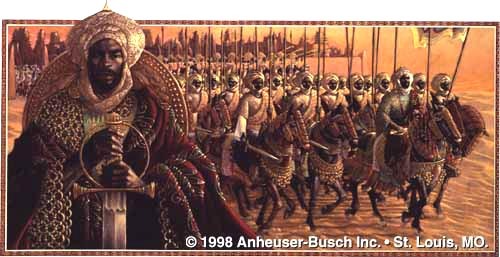 When Sunni Ali Ber came to power, Songhay was a small kingdom in the western Sudan. But during his twenty-eight year reign, it grew into the largest, most powerful empire in West Africa. Sunni Ali ruled from horseback, leading his country while leading his army. He built a remarkable army-not farmers hastily pressed into service, but full time, professional soldiers, including a horse and camel cavalry with men in armor. With this ferocious force, the warrior king won battle after battle. He routed marauding nomads, seized trade routes, took villages, and expanded, ever expanded, his domain. He captured Timbuktu, bringing into the Songhay Empire a major center of commerce, culture, and Moslem scholarship. He conquered the city of Jenne, invincible for centuries, with a relentless seven-year siege. Sunni Ali was both feared by his enemies and revered by his people, who called him Ali the Great. His greatness is still legendary among the Songhay people today. http://www.beltonfamily.org/index.php?option=com_content&view=article&id=26&Itemid=56 Songhai empire: 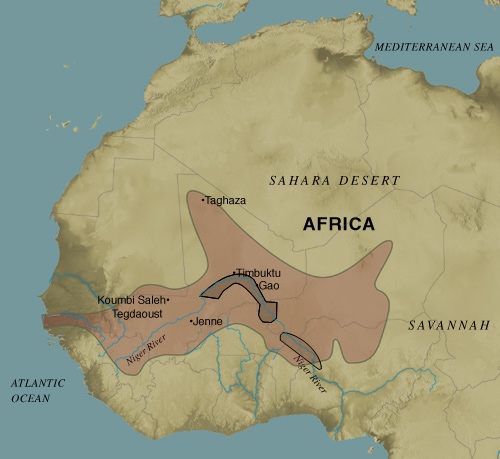 |
| Re: Deadliest Black/African Warriors!!!! by stupor(m): 3:47am On Apr 20, 2013 |
@ OP Did you fòrget to include thóusands of Epic Nigerian warriOrs ? Abi you think say Nigerians nò dey fight war ? Abeg kindly re-update pls. |
| Re: Deadliest Black/African Warriors!!!! by Nobody: 3:49am On Apr 20, 2013 |
stupor: @ OP I'm sorry, but I am not well informed on Nigerian warriors.  Thats why I ask you guys to please help contribute. If you post some Nigerian warriors that would be nice. I'll try to look some up. |
| Re: Deadliest Black/African Warriors!!!! by Nobody: 3:56am On Apr 20, 2013 |
Man where is MsDarkskin...I would love for her to post some interesting info on the Jamaican Maroons. |
| Re: Deadliest Black/African Warriors!!!! by Nobody: 4:06am On Apr 20, 2013 |
Gaspar Yanga  Known as the Primer Libertador de America or “first liberator of the Americas,” Gaspar Yanga led one of colonial Mexico’s first successful slave uprisings and would go on to establish one of the Americas earliest free black settlements. Rumored to be of royal lineage from West Africa, Yanga was an enslaved worker in the sugarcane plantations of Veracruz, Mexico. In 1570 he, along with a group of followers, escaped, fled to the mountainous regions near Córdoba, and established a settlement of former slaves or palenque. They remained there virtually unmolested by Spanish authorities for nearly 40 years. Taking the role of spiritual and military leader, he structured the agricultural community in an ordered capacity, allowing its growth and occupation of various locations. During that time, Yanga and his band, also known as cimarrónes, were implicated in the disruption and looting of trade goods along the Camino Real (Royal Road) between Veracruz and Mexico City. They were also held responsible for attacking nearby haciendas and kidnapping indigenous women. Perceived as dangerous to the colonial system of slavery through their daring actions against royal commerce and authority, New Spain’s viceroy called for the annihilation of Yanga's palenque. Destroying the community and its leader would send a message to other would-be rebellious slaves that Spain’s authority over them was absolute. In 1609, Spanish authorities sent a well-armed militia to defeat Yanga and his palenque but were defeated. Yanga’s surprise victory over the Spanish heightened the confidence of his warriors and the frustration in Mexico City. After defeating other Spanish forces sent again the palenque, Yanga offered to make peace but with eleven conditions, the most important being recognition of the freedom of all of the palenque’s residents prior to 1608, acknowledgment of the settlement as a legal entity which Yanga and his descendants would govern, and the prohibition of any Spanish in the community. Yanga, in turn, promised to serve and pay tribute to the Spanish crown. After years of negotiations, in 1618, the town of San Lorenzo de Los Negros was officially recognized by Spanish authorities as a free black settlement. It would later be referred to as Yanga, named after its founder. Source: http://www.blackpast.org/?q=gah/yanga-gaspar-c-1545 |
| Re: Deadliest Black/African Warriors!!!! by pleep(m): 4:11am On Apr 20, 2013 |
The real heroes of Biafra 2 Likes
|
| Re: Deadliest Black/African Warriors!!!! by Nobody: 4:23am On Apr 20, 2013 |
Zumbi(Afro-Brazilian)  Quilombos were fugitive settlements or African refugee settlements. Quilombos represented free African resistance which occurred in three forms: Free settlements, attempts at seizing power, and armed insurrection. Members of quilombos often returned to plantations or towns to encourage their former fellow Africans to flee and join the quilombos. If necessary, they brought others by force and sabotaged plantations. Anyone who came to quilombos on their own were considered free, but those who were captured and brought by force were considered slaves and continued to be so in the new settlements. They could be considered free if they were to bring another captive to the settlement. Quilombo dos Palmares was a self-sustaining republic of Maroons escaped from the Portuguese settlements in Brazil, "a region perhaps the size of Portugal in the hinterland of Bahia" (Braudel 1984 p 390). At its height, Palmares had a population of over 30,000. Forced to defend against repeated attacks by Portuguese colonists, many warriors of Palmares were expert in capoeira, a martial arts form that was brought to and enhanced in Brazil by African slaves at about the 16th century on. By 1678, the governor of the captaincy of Pernambuco, Pedro Almeida, weary of the longstanding conflict with Palmares, approached its leader Ganga Zumba with an olive branch. Almeida offered freedom for all runaway slaves if Palmares would submit to Portuguese authority, a proposal which Ganga Zumba favored. But Zumbi was distrustful of the Portuguese. Further, he refused to accept freedom for the people of Palmares while other Africans remained enslaved. He rejected Almeida's overture and challenged Ganga Zumba's leadership. Vowing to continue the resistance to Portuguese oppression, Zumbi became the new leader of Palmares. Fifteen years after Zumbi assumed leadership of Palmares, Portuguese military commanders Domingos Jorge Velho and Bernardo Vieira de Melo mounted an artillery assault on the quilombo. February 6, 1694, after 67 years of ceaseless conflict with the cafuzos, or Maroons, of Palmares, the Portuguese succeeded in destroying Cerca do Macaco, the republic's central settlement. Before the king Ganga Zumba was dead, Zumbi had taken it upon himself to fight for Palmares' independence. In doing so he became known as the commander-in-chief in 1675. Due to his heroic efforts it increased his prestige. Palmares' warriors were no match for the Portuguese artillery; the republic fell, and Zumbi was wounded in one leg. http://en.wikipedia.org/wiki/Zumbi African slave fight style Capoeira:  |
| Re: Deadliest Black/African Warriors!!!! by pleep(m): 4:27am On Apr 20, 2013 |
^ very |
| Re: Deadliest Black/African Warriors!!!! by Nobody: 4:37am On Apr 20, 2013 |
^ da fuq ,pleep |
| Re: Deadliest Black/African Warriors!!!! by Nobody: 4:46am On Apr 20, 2013 |
| Re: Deadliest Black/African Warriors!!!! by ow11(m): 8:40am On Apr 20, 2013 |
Toussaint L'Ouverture Leader of the Haitian Revolution also known as Black Spartacus! Othman Dan Fodio! Conquered most of the settlements in present day Northern Nigeria. The following guys are not warriors but they harassed the European invaders Nelson Mandela (RSA) Omar Mukhtar (LIBYA) Patrice Lumumba (DRC) Margret Ekpo (NGR) Kwame Nkrumah (GHA) Oba Ovonramwen Nogbaisi (NGR) |
(1) (2) (3) (4) (5) (6) (7) (8) (9) (10) (Reply)
COVID-19 In US: Thousands Lineup Orderly In Their Cars To Get Food, Items(Pics) / Kim Yo-Jong, Jong-Un's Sister To Lead North Korea If He Dies / Gov.
(Go Up)
| Sections: politics (1) business autos (1) jobs (1) career education (1) romance computers phones travel sports fashion health religion celebs tv-movies music-radio literature webmasters programming techmarket Links: (1) (2) (3) (4) (5) (6) (7) (8) (9) (10) Nairaland - Copyright © 2005 - 2024 Oluwaseun Osewa. All rights reserved. See How To Advertise. 96 |
